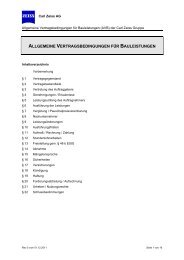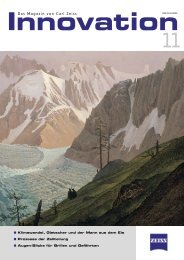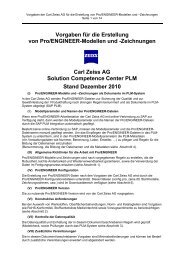Download PDF - Carl Zeiss
Download PDF - Carl Zeiss
Download PDF - Carl Zeiss
Create successful ePaper yourself
Turn your PDF publications into a flip-book with our unique Google optimized e-Paper software.
dentally, is usually carried out in the<br />
ZFB in parallel to the restoration<br />
measures?<br />
Heritage is an<br />
ongoing duty<br />
Viewing words, sentences, images<br />
and drawings on a screen alone is<br />
just not the same as still being able<br />
to hold in your hand the pieces of<br />
paper on which, centuries ago, a<br />
good proportion of what forms the<br />
basis of our history and culture today<br />
was written down, drawn or printed.<br />
In any case, the passage of time and<br />
events have already destroyed or<br />
ruined much of this. What still remains<br />
should not be seen as a problem<br />
that we have inherited but as a<br />
duty, and the effort of preserving it<br />
must be regarded as being worthwhile,<br />
even for our own sakes.<br />
Manfred Schindler<br />
manfred.schindler@msw.de<br />
Innovation 15, <strong>Carl</strong> <strong>Zeiss</strong> AG, 2005<br />
details<br />
Microscopy<br />
3 4<br />
Books have many different enemies:<br />
mice, bookworms, light,<br />
micro-organisms and acid. Recording<br />
the damage that a book<br />
has suffered always forms the<br />
starting point of a comprehensive<br />
strategy for book preservation.<br />
Microscopes, especially stereomicroscopes,<br />
are frequently used<br />
in the restoration of books to<br />
analyze the book’s “state of<br />
health” before work begins on it:<br />
a record is made of the book<br />
materials and images of the<br />
damage.<br />
Liposcelis divinatorius, for example,<br />
is a minute, wingless type of<br />
book louse that lives between the<br />
pages of books. It prefers to live<br />
in a moist, warm environment and<br />
feeds on mildew, starch, organic<br />
glue, fabric, paper, silk and<br />
leather. Its natural predator is the<br />
book scorpion.<br />
Discoloration of paper and parchment<br />
is usually the sign of an<br />
infestation by micro-organisms<br />
(mildew, bacteria). These are<br />
usually single-cell organisms,<br />
which can be seen under the<br />
microscope. Dye stuffs, excreted<br />
by the micro-organisms, turn<br />
paper green, brown, red, yellow<br />
and black, while parchment is<br />
more likely to show purple marks.<br />
These marks remain even after<br />
the perpetrator has died. However,<br />
colored spots also occur<br />
if the paper has been attacked by<br />
micro-organisms in its structure.<br />
5<br />
Fig. 3:<br />
Aqueous fungicide<br />
treatment to kill mildew.<br />
Fig. 4:<br />
Removal of ash and lime.<br />
Fig. 5:<br />
Paper deterioration<br />
caused by acid.<br />
45
















